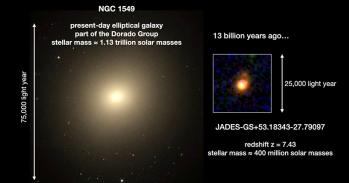
In the eighth of a series of reports contributed by Cambridge researchers, we hear about Dr John Richer’s night-time research activities at the ALMA observatory in Chile's Atacama desert.
In the eighth of a series of reports contributed by Cambridge researchers, we hear about Dr John Richer’s night-time research activities at the ALMA observatory in Chile's Atacama desert.
This is no place for spontaneity. The low oxygen content of our blood impairs our decision making, even if topped up with our oxygen cylinders. Sleep here is dangerous and forbidden: there are no beds at the high site.
Dr John Richer
Timing is everything. I'm in the daily 3 pm planning meeting at the Observation Support Facility (OSF), and the talk is all about missing nanoseconds. One thousand millionth of a second. Even light can travel only 30 cm in a nanosecond. On the wall, a large screen shows live images of 20 white radio antennas, sitting on a 16,500 ft plateau 28 km from here in the high Chilean Andes. The signals from each antenna must be synchronised with phenomenal precision to create a telescope 10 miles in diameter – hence the concern about the nanosecond errors in the computer system.
A small army of scientists and engineers of the Atacama Large Millimeter/submillimeter Array (ALMA) project live and work at the OSF, assembling, testing and operating the telescope 28 km distant. At 9,500 feet above sea level, the OSF has sufficient oxygen to allow us to work and sleep safely. All the telescope components arrive here for assembly and testing. Only when the systems pass stringent tests are the 100-tonne antennas allowed up to what we all call “the high site”, the spectacular Chajnantor plateau. Its rarefied air is bone dry: even the tiniest amount of water vapour would be sufficient to block the faint radio waves that ALMA is trying to detect. Here, we can make spectacular images of the cold dust and gas in the distant universe, revealing the origins of new stars, planets and galaxies.
Flora and fauna are rare in this desert. A few cacti and some hardy flowers eke out an existence. Occasionally a vicuña or fox may stray across the site. For humans too, Chajnantor is a hostile environment. Earlier today, I had travelled to the high site to calibrate one of our atmospheric measurement instruments. Before the drive up, we are assessed by the medics. Blood pressure: low. Blood oxygen level: high. I’m good to go. We’re then provided with personal oxygen tanks and blood oxygen monitors. Everest anyone?
The drive from the OSF to the high site takes 45 minutes. Arriving at our instrument, we spend a couple of hours outside on the cold and windy plateau, pouring liquid nitrogen into the system to calibrate it. The nitrogen boils furiously. We take regular brakes to check our blood oxygen levels and deep breathe from our portable oxygen tanks. Nitrogen and oxygen: the constituents of air, separated and bottled for very different purposes, but both essential for our mission here. We follow our check list of activities meticulously. This is no place for spontaneity. The low oxygen content of our blood impairs our decision making, even if topped up with our oxygen cylinders. Sleep here is dangerous and forbidden: there are no beds at the high site.
Returning to the OSF, we see the occasional observatory vehicle, kicking up a plume of dust as it descends the wide dirt road. The antennas themselves make their way up this road once assembly is complete, to join the growing array at the high site. Within two years, 66 antennas will work in unison and ALMA will be complete. Down to the west, the barren desert stretches out as far as we can see, and the salt lakes near San Pedro de Atacama glint as they reflect the sun low in the clear blue sky.
We head to the control room at 4 pm where the night-time testing is beginning: the antennas on the large screen start to move as the operators run them through the planned series of test observations. A high wind alert causes them to stow automatically, the paraboloidal dishes pointing away from the wind, cowering from the stiff breeze. But as the sun sets, the wind abates, the antennas awake and the testing continues. The scientists stare at their computers, looking for clues in the data – will the missing nanoseconds be found tonight?
In the early morning, I head back to my portacabin room to sleep a fitful, anxious sleep. The extreme aridity causes me to wake every two hours, desperate for water to slake my thirst. The dryness and altitude are harsh: but they are the reasons we are here in this beautiful desolation.
Dr John Richer
John is from the University of Cambridge’s Department of Physics and Kavli Institute for Cosmology, and a fellow at Churchill College. For the past 11 years he has been the UK Project Scientist for ALMA (www.almaobservatory.org), a 20-country international collaboration funded in the UK by the Science and Technology Facilities Council. Its goal is to make the first high-resolution images of the formation of stars, planets and galaxies throughout the universe. John’s research is funded by the UK Science and Technology Facilities Council and the European Union’s Framework 6 program.
This work is licensed under a Creative Commons Licence. If you use this content on your site please link back to this page.





